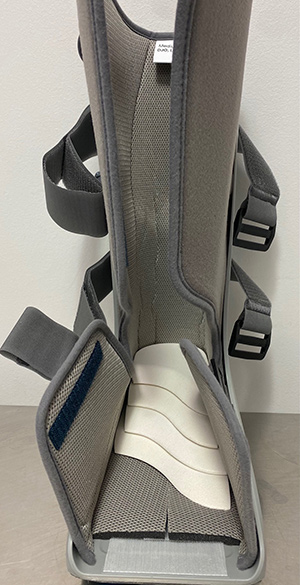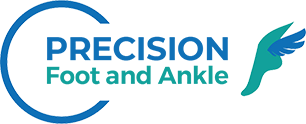Achilles Tendon Rehabilitation
Boot and Wedge Protocol
The protocol below is an outline of stages you will progress following a rupture of the Achilles tendon, or its surgical repair.
You may initially be in a cast or boot. This is to be kept on until you are seen in the clinic following your injury or your surgery. Please keep the leg elevated above the level of the chest during this time. If in a boot, you are allowed to weight bear and walk as you feel comfortable. Elbow crutches may help you mobilise. If you are in a cast, you are advised to remain non-weight bearing, until you are seen in the clinic.
A physiotherapy referral request will be made at the beginning of your treatment and you will typically be seen by the team eight to ten weeks following the injury or surgery. The protocol below may differ according to the individual.
Weeks 0-2 following injury or Achilles surgery
- Weight bear as tolerated if in a boot or NWB with cast and use of crutches or a frame to aid mobility
- Try to keep your hips, knees and toes moving fully to prevent stiffness
- No physiotherapy or range of movement exercises yet
- You must keep the cast or boot on at all times (day and night)
- Rest and elevate leg as much as possible
- Take painkillers regularly
Week 2-8
- Four wedges are placed under the heel in your boot to begin with. You must remove one wedge every two weeks. You will be shown how by the plaster technician initially- remove the wedge from the bottom of the stack each time. Your Physiotherapist can also help guide you with this.
- You can fully weight bear in the boot with crutches as comfort allows
- Try to keep your hips, knees and toes moving fully to prevent stiffness
- Rest and elevate leg as much as possible. The boot should be worn at all times, except for showering (if you are allowed and you have had your wound check if your injury has been managed with surgery) - keep the foot facing down.

The picture above shows the boot and wedges that are used following Achilles tendon injury or following surgery.
Week 8-10
- All four wedges should now have been removed.
- It is important to keep the boot on as a rupture of the tendon can still occur.
- Your physiotherapist will teach you some gentle strengthening exercises with a band for pointing your toes down (plantarflexion) and turning your foot in and out (inversion and eversion)
- You can actively pull your foot up towards you (dorsiflexion) using your muscles until a gentle tension is felt in your Achilles tendon Do not force this movement or use anything to pull your foot up towards you.
- You will be shown some proprioception/balance work to be completed in your boot
Week 10-12
- The boot can be removed and you can transition to a flat shoe with single heel raise for 2-4 weeks. These heel raises are made of foam or gel. These can be obtained online or over the counter by a chemist. The boot can be worn in vulnerable environments, if necessary. Remember to take a shoe to this clinic appointment.
- You may need a crutch to help you walk initially or until you are able to walk without a limp. Avoid hyperextension of the knee (pushing your knee back excessively) to compensate for lack of ankle movement
- Wean yourself out of your crutches as you are able.
- Try to achieve full movement at your ankle You can start with a gentle calf stretch in standing but do not push this into a strong stretch.
- You can start gentle ankle strengthening exercises. Bring your toes up towards you (dorsiflexion) to match the other foot. This will progress toward band exercises.
- Continue to practice resisted movements turning your foot in and out (inversion/eversion) as far as is possible
- You can use an exercise bike to help keep yourself strong (low resistance)
- Aim to climb stairs normally. Progress walking up and down slopes
- Swimming and gentle stretches whilst in the water are beneficial.
Your tendon is still very vulnerable and you need to be diligent with activities of daily living and exercises. Any sudden loading of the Achilles tendon (e.g. trip, step upstairs etc.) may result in a re-rupture.
Week 12 -16 (3-4 months)
- Continue with proprioception / balance exercises
- Aim to be able to have good balance control when wearing normal good supportive footwear
- Continue to progressively strengthen your leg, foot and ankle
- Your Physiotherapist will progress you to exercises such as heel raises and other exercises as necessary for your specific rehabilitation
- Aim for normal dorsiflexion range (pulling toes up towards you), no need to push to extreme
Weeks 16-24 (4-6 months)
Sports Preparation
- Aim for ankle strength to near full strength
- Aim for restoration of a normal walking pattern
- Aim to be wearing normal shoes without a heel raise
- Continue to be careful on stairs and uneven, rough ground
- Aim to be able to have good balance control when wearing normal, good supportive footwear
- You can continue to perform stretches for your calf muscles but do not push this beyond neutral (i.e. not on the edge of a step). There should not be a strong stretch felt in your calf
- Aim for restoration of a normal walking pattern
- You may start jogging on a treadmill, gradually progressing to jogging on flat ground with guidance from your physiotherapist
- You may progress jogging to running, including change of direction work/cutting, fast acceleration/deceleration with guidance from your physiotherapist as control and strength allows
- Start to include sports specific rehabilitation type exercises under guidance from your physiotherapist
Pain after exercise should subside to a normal level by the following morning and there should be no increase in pain on a week to week basis. If the pain persists exercises should be altered to a level that allows the pain to subside to a normal level by the following morning.
Week 24 onwards (6 months onwards)
Goals
- Return to full function
- Return to sport (dependent on the sport) as able
- You can start to stretch and exercise your calf beyond neutral (i.e. on edge of step)
- You can complete sports specific exercises including dynamic drills e.g. hopping, skipping
Long term outlook
Generally, the outlook is very good. However, the tendon does take six to nine months to recover and rehabilitate. It may not regain the same strength as the uninjured side, whether treated conservatively or with an operation.
Work
If you have an office-based job then it may be possible to return to work after two weeks following injury or surgery. You will have a cast or boot on and will require a foot stool to keep the leg elevated. If you have a more physical job, then it may take 12-16 weeks to return to work.
Driving
You should not drive a manual car for at least nine weeks following your injury. After this time you should start to drive gradually. This will be more difficult if your car pedals are stiff to use. It normally takes a few days to feel confident. If you have an automatic car and it is your left Achilles tendon that is affected, you may be able to drive earlier at about two weeks following injury or surgery. If the right Achilles tendon is affected, you will not be able to drive for nine weeks at a minimum. You are advised to contact your insurance company prior to driving.
Sport
Time to return is between 4-12 months depending on the sport and on your strength and ability to perform the necessary skills.
Complications
- Whichever treatment option is followed, there is a chance that the tendon will not heal fully and further treatment such as surgery may be necessary.
- The tendon may scar or may become shorter during the healing process, leaving the ankle feeling stiff.
- There is also a chance that the tendon could become torn again later (re-rupture).
